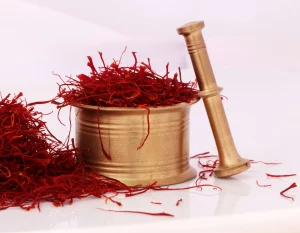Saffron versus Salt
When it comes to elevating dishes, few ingredients carry as much weight as salt and saffron. Both are ancient, both are prized, and both can completely transform a recipe – but in very different ways. This guide explores what makes each unique, how they compare, and how you can use them together for unforgettable results.
What Is Salt?
Salt is the backbone of flavor. It enhances taste, balances sweetness, cuts bitterness, and draws out the best in other ingredients. Whether it’s Himalayan pink salt, flaky sea salt, kosher salt, or everyday table salt, this mineral is universal in kitchens around the globe. Salt doesn’t just season food – it defines it.
Types of Salt
- Himalayan Pink Salt: Mined from ancient salt deposits, with trace minerals and a rosy hue.
- Sea Salt: Harvested from evaporated seawater, often coarse and mineral-rich.
- Kosher Salt: Known for its flaky texture and ease of handling.
- Table Salt: The most common, refined and often fortified with iodine.
The Role of Salt in Cooking
Salt seasons, preserves, and enhances food. It strengthens gluten in bread, balances sweetness in desserts, and brings out the flavor of meats, vegetables, and sauces.
Health Benefits and Risks of Salt
In moderation, salt helps regulate fluid balance, nerve signals, and muscle contractions. Natural salts contain trace minerals, though nutritionally similar to table salt. Excess intake, however, can raise blood pressure – making balance essential.
What Is Saffron?
Saffron is the jewel of the spice world. Derived from the delicate stigmas of the crocus flower, it’s one of the most expensive spices in existence due to the painstaking harvesting process.
Where Saffron Comes From
Primarily cultivated in Iran, Spain, and parts of India, saffron has been treasured for centuries in Middle Eastern, Mediterranean, and South Asian cuisine.
Why Saffron Is So Expensive
Each flower produces only three stigmas, which must be harvested by hand. It takes thousands of flowers to produce a single ounce of saffron threads, making it a true luxury ingredient.
Flavor Profile and Culinary Uses
Saffron has a floral, earthy, and slightly sweet flavor that infuses dishes with aroma and a golden hue. It’s used in paella, risotto, biryanis, stews, teas, and even desserts.
Health Benefits of Saffron
Rich in antioxidants like crocin and safranal, saffron may help boost mood, support memory, reduce PMS symptoms, and promote heart health.
Saffron vs. Salt: Key Differences
- Flavor and Aroma: Salt enhances existing flavors; saffron introduces a distinct, luxurious note.
- Cost and Availability: Salt is affordable and abundant; saffron is rare and expensive.
- Everyday Use vs. Special Occasions: Salt is essential daily; saffron is used sparingly for standout recipes.
- Cultural and Historical Significance: Salt symbolizes preservation and purity, while saffron represents luxury, celebration, and wellness.
Salt and Saffron Together in Cooking
Though different, these two ingredients often work beautifully together.
How Salt Enhances Saffron’s Flavor
Salt anchors saffron’s delicate notes, making them more pronounced without overwhelming the dish.
Classic Dishes with Saffron and Salt
- Spanish Paella
- Italian Risotto alla Milanese
- Indian Biryani
- Persian Tahdig
Cooking Tips for Balancing Salt and Saffron
- Infuse saffron in warm water or broth before adding it to dishes.
- Always taste and season carefully – too much salt can mask saffron’s subtleties.
- A sprinkle of flaky salt can add contrast and texture to saffron-rich foods.
Substitutes and Alternatives
Salt Substitutes
- Herbs and Spices: Garlic powder, smoked paprika, citrus zest.
- Potassium-Based Alternatives: Commercial low-sodium salts.
Saffron Substitutes
- Turmeric vs. Saffron: Turmeric offers color but not saffron’s flavor.
- Safflower and Paprika: A blend for color and mild taste.
- When to Use Substitutes: For everyday dishes where saffron’s luxury isn’t essential.
Health Benefits: Saffron vs. Salt
- Antioxidants in Saffron: Support mood, memory, and heart health.
- Electrolyte Role of Salt: Maintains hydration, nerve signals, and muscle function.
- Moderation Matters: Both can enhance wellness when used thoughtfully.
When to Use Saffron vs. Salt
- Everyday Cooking with Salt: From soups and salads to baked goods and marinades.
- Special Occasion Dishes with Saffron: Paella, biryani, luxurious desserts, and festive drinks.
- How to Pair Them: Use saffron to elevate; use salt to balance.
FAQ
Yes! Turmeric, safflower, or paprika provide color; for both color and flavor, try ¼ tsp turmeric plus ½ tsp paprika per pinch of saffron.
It brings a gentle, floral-earthy sweetness – subtle and luxurious, not spicy, perfect for delicate dishes.
Because harvesting is massively labor-intensive – each flower only yields three tiny stigmas, so producing even a small amount requires thousands of flowers.
Lightly crush saffron threads and soak them in warm liquid (water, milk, or broth) for at least 10 minutes to coax out their color and flavor – then stir the infused liquid into your dish.
Final Thoughts: Saffron vs. Salt in Your Kitchen
Salt and saffron may play different roles in the kitchen, but together they create harmony. Salt is the steady foundation, while saffron is the flourish that turns food into art. Both deserve a place in your pantry, and knowing when to use each can transform your cooking.
